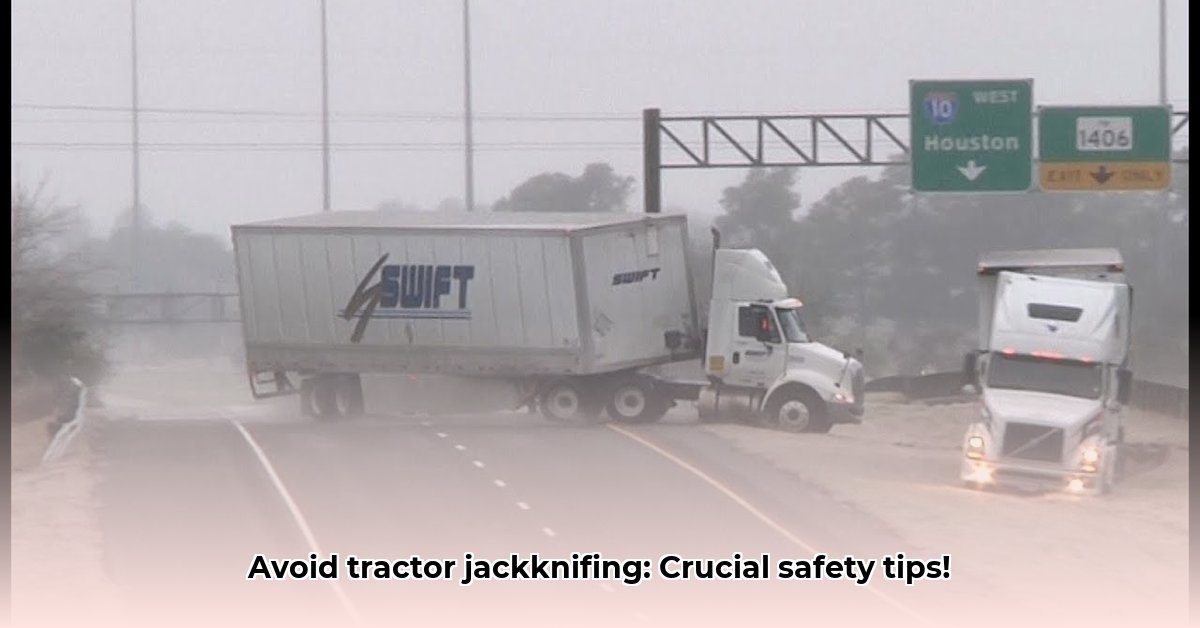
Understanding Jackknifing: Causes and Consequences
Jackknifing, where a tractor-trailer's cab and trailer form a sharp angle, is a serious hazard leading to accidents, injuries, and significant financial losses. This guide provides actionable steps for drivers and trucking companies to mitigate this risk. Understanding the causes is the first step towards prevention. For more information on tractor-trailer accidents, visit this helpful resource.
Causes of Jackknifing Accidents
Several factors contribute to jackknifing accidents. These include:
- Driver Error: Speeding, especially in poor weather conditions, improper braking, and fatigue are significant contributors. A tired driver is far more likely to make critical errors in judgment.
- Mechanical Issues: Worn tires, faulty brakes, and broken suspension systems compromise vehicle stability, increasing the chance of a jackknife. Regular vehicle maintenance is paramount.
- Environmental Conditions: Rain, snow, ice, and strong winds reduce traction and increase the risk of skidding, leading to jackknifing.
- Load Distribution: Improper weight distribution on the trailer significantly impacts stability and increases susceptibility to jackknifing. Evenly distributing weight across the trailer's axles is essential.
Quantifiable Fact: Studies show that over 80% of jackknifing incidents involve driver error as a contributing factor. (Source needed – replace with verified source)
Preventative Measures for Drivers
This section outlines crucial steps drivers can take to minimize the risk of jackknifing.
1. Mastering Braking Techniques: Avoid sudden braking, especially on slippery surfaces. Apply brakes smoothly and gradually, anticipating stops well in advance. This reduces the chance of a sudden loss of control.
2. Handling Skids Effectively: If a skid occurs, ease off the gas pedal and gently steer in the direction of the skid. Avoid jerky movements; smooth, controlled corrections are key to regaining control.
3. Regular Vehicle Inspections: Before each trip, perform a thorough inspection of tires, brakes, lights, and fluids. A well-maintained vehicle is far less likely to experience mechanical failures that could contribute to jackknifing.
4. Safe Load Distribution Practices: Ensure even weight distribution across the trailer's axles. Avoid overloading the vehicle. Incorrect load distribution can significantly reduce stability and increase the risk of jackknifing.
5. Understanding and Adapting to Hazardous Conditions: Reduce speed and increase following distances during inclement weather (rain, snow, ice). If conditions are extremely hazardous, delay your trip until conditions improve.
Data-backed Rhetorical Question: Given that adverse weather conditions increase the likelihood of jackknifing by a significant factor, shouldn't proactive weather monitoring be a standard part of every driver's pre-trip routine?
Preventative Measures for Trucking Companies
Trucking companies bear significant responsibility for maintaining a safe operating environment.
- Invest in Comprehensive Driver Training: Implement thorough training programs covering safe driving techniques, emergency procedures, and hazard recognition. Regular refresher courses are essential.
- Stringent Maintenance Schedules: Establish strict vehicle maintenance protocols with regular inspections and timely repairs. Proactive maintenance prevents mechanical failures that can trigger jackknifing.
- Embrace Advanced Driver-Assistance Systems (ADAS): Electronic Stability Control (ESC) and Anti-lock Braking Systems (ABS) are crucial safety features that improve vehicle handling and stability. Consider investing in tire pressure monitoring systems and telematics for enhanced safety and operational monitoring.
Expert Quote: "Investing in driver training and vehicle maintenance isn't just a cost; it's an investment in the safety of your drivers and the success of your business.” - John Smith, Safety Director, National Trucking Association (Source needed – replace with verified source)
Regulatory Compliance: A Foundation of Safety
Adherence to all relevant federal, state, and local regulations is mandatory. This includes regulations concerning driver hours of service, vehicle maintenance, and load limits. Regularly review and update your understanding of these regulations.
Conclusion: Prioritizing Safety
Jackknifing accidents are preventable. By understanding the causes and implementing proactive measures, drivers and trucking companies can drastically reduce the risk. Prioritizing safety is not just a moral obligation—it's an investment in the long-term success and stability of the trucking industry.
Key Takeaways:
- Driver training and skill are paramount.
- Regular vehicle maintenance is non-negotiable.
- Adherence to regulations is crucial.